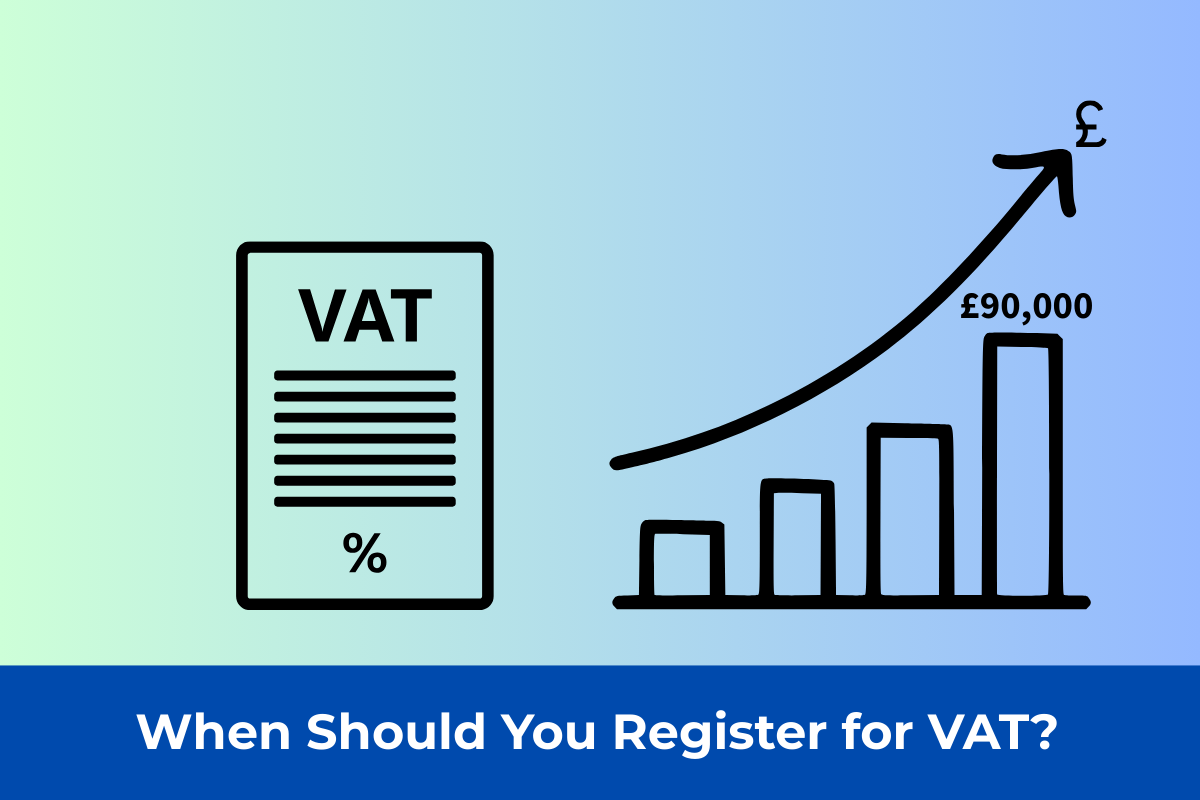VAT (Value Added Tax) is charged on most goods and services sold in the UK. If you’re VAT-registered, you collect VAT from customers and pay it to HMRC (usually quarterly). Some businesses must register; others can register voluntarily to gain advantages.
This guide explains when you must register, when it can be worth doing it early, and what happens next.
Watch my quick guide to VAT — when to register, how it works, and common mistakes to avoid.
1) When you must register for VAT
You must register if either test applies:
✅ The 12-month rolling test (historic test)
- Your taxable turnover (standard-rated + reduced-rated + zero-rated sales; exclude exempt sales) exceeds £90,000 in any rolling 12-month period.
- You must register by the end of the following month.
- Your effective date of registration is the first day of the month after you went over the threshold (unless HMRC directs otherwise).
Example:
Turnover from 15 Sep 2024 to 14 Sep 2025 hits £91,500 → you must register by 31 Oct 2025, and begin charging VAT from your effective date (normally 1 Oct 2025).
✅ The 30-day future test
- If you know your taxable turnover will exceed £90,000 in the next 30 days alone (e.g., a large contract), you must register immediately.
- Your effective date is the date you realised you would exceed it.
Other compulsory cases
- You take over a VAT-registered business and the rolling turnover remains above the threshold → register straight away.
- Non-UK sellers supplying certain goods/services to UK customers may have UK VAT obligations (e.g., digital services) even below the threshold.
Missed the deadline? HMRC can backdate your registration and charge penalties and interest on under-declared VAT.
2) Should you register voluntarily?
If your taxable turnover is below £90,000, you can register. It can help when:
- Your customers are mainly VAT-registered businesses (they reclaim the VAT you charge).
- You incur significant input VAT on expenses/equipment and want to reclaim it.
- You want the credibility of being VAT-registered.
Watch-outs:
- If you sell to consumers (B2C), adding 20% VAT may make your prices look higher.
- More admin: Making Tax Digital (digital records + quarterly returns) applies to all VAT-registered businesses.
3) Picking a VAT accounting method (quick overview)
- Standard scheme: Invoice basis; reclaim input VAT on purchases.
- Cash Accounting scheme: Pay/reclaim VAT based on cash received/paid (helps with cash flow).
- Flat Rate Scheme (FRS): Pay a fixed % of gross turnover; simpler, but you can’t usually reclaim input VAT (except certain capital items). Often helpful for service businesses with low costs.
(We can advise which scheme best fits your margins and customers.)
4) Zero-rated vs Exempt — why it matters
- Zero-rated sales (0%) still count toward the £90,000 threshold and let you reclaim input VAT.
- Exempt sales (e.g., certain finance, rent on residential property) don’t count toward the threshold and usually block input VAT recovery linked to those supplies.
5) How to register and what happens next
- Apply online via your Government Gateway account.
- HMRC issues your VAT number — display it on invoices, website, and stationery.
- Start charging VAT from your effective date.
- Keep digital records and file VAT returns (usually quarterly).
- Reclaim input VAT on allowable business costs.
Quick checklist
- Track taxable turnover monthly (rolling 12 months).
- If close to £90,000, model your price/ margin impact.
- Choose a VAT scheme (Standard / Cash / FRS).
- Set up MTD-compatible bookkeeping (Xero, QuickBooks, FreeAgent).
- Update invoice templates with VAT number and correct rates.
- Plan cash flow for VAT payments.
Related GCA blogs to help
- VAT Made Easy — Your Fun Guide to Value Added Tax (overview and demystifier)
- Top 5 Tax Mistakes UK Business Owners Make (and How to Avoid Them) (common VAT pitfalls included)
- How to Set Up a Small Business in the UK – Step-by-Step (start-up flow incl. VAT)
Final thought
Registering at the right time (and on the right scheme) can protect your margins and avoid penalties. If you’re near the threshold or unsure whether to register voluntarily, get tailored advice.
Book a clarity call — we’ll run the numbers and set you up correctly.
